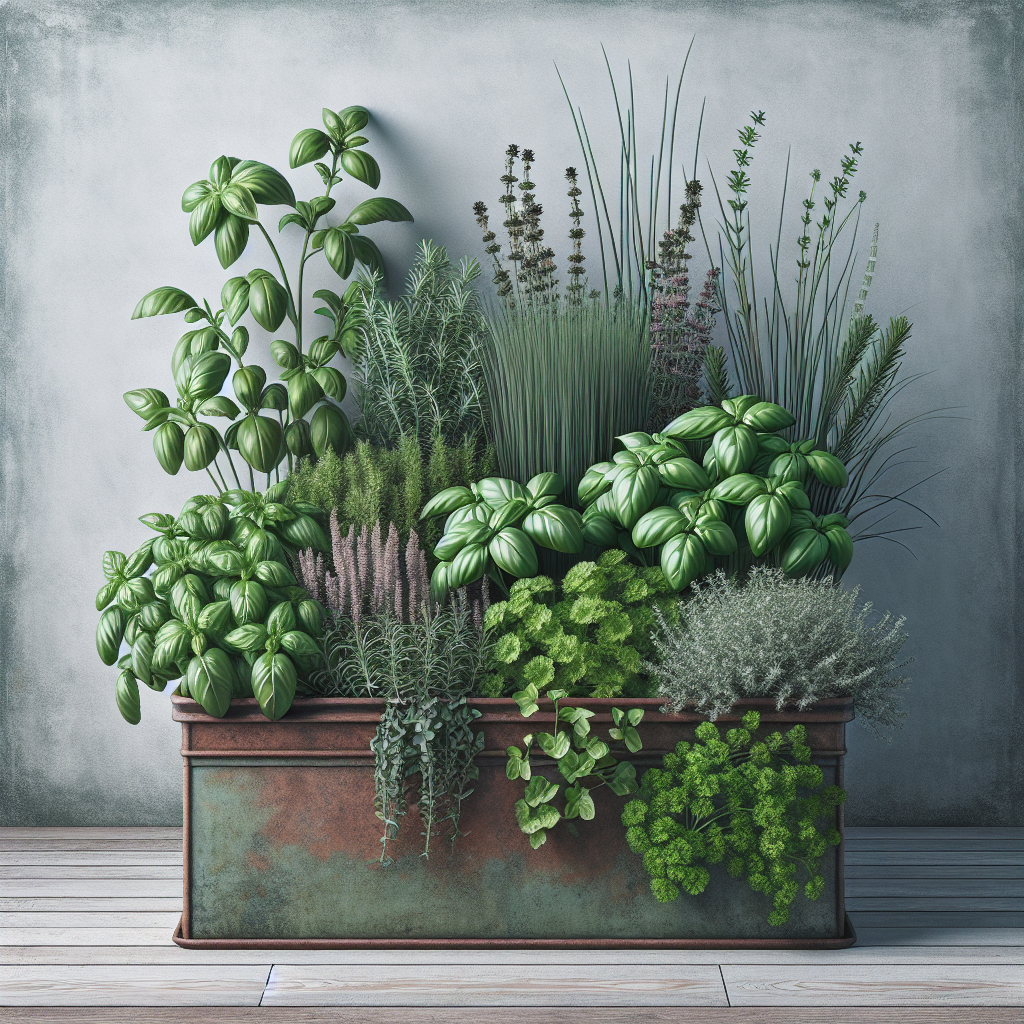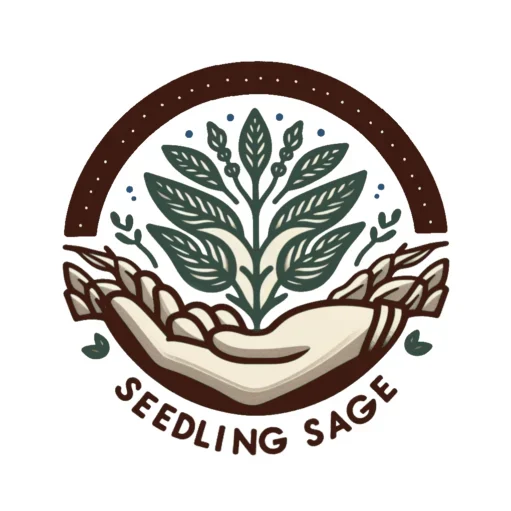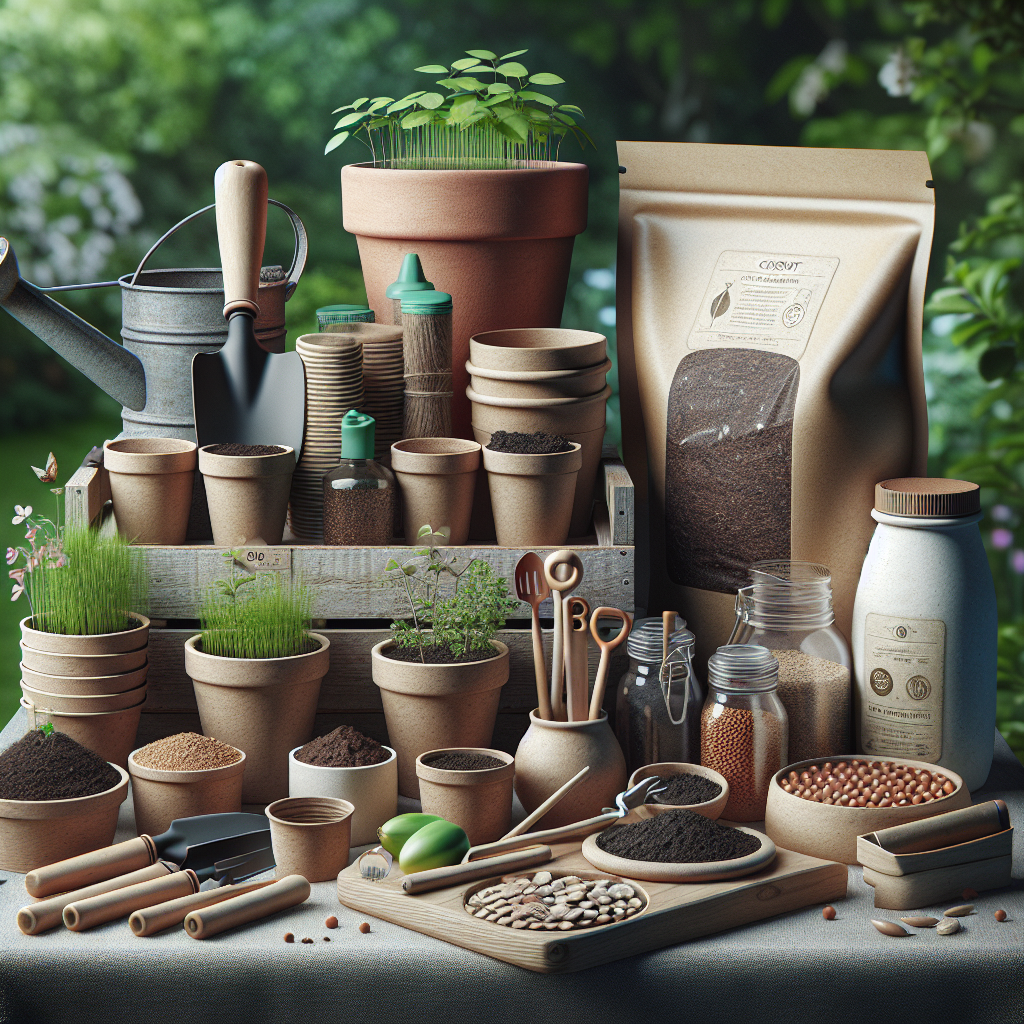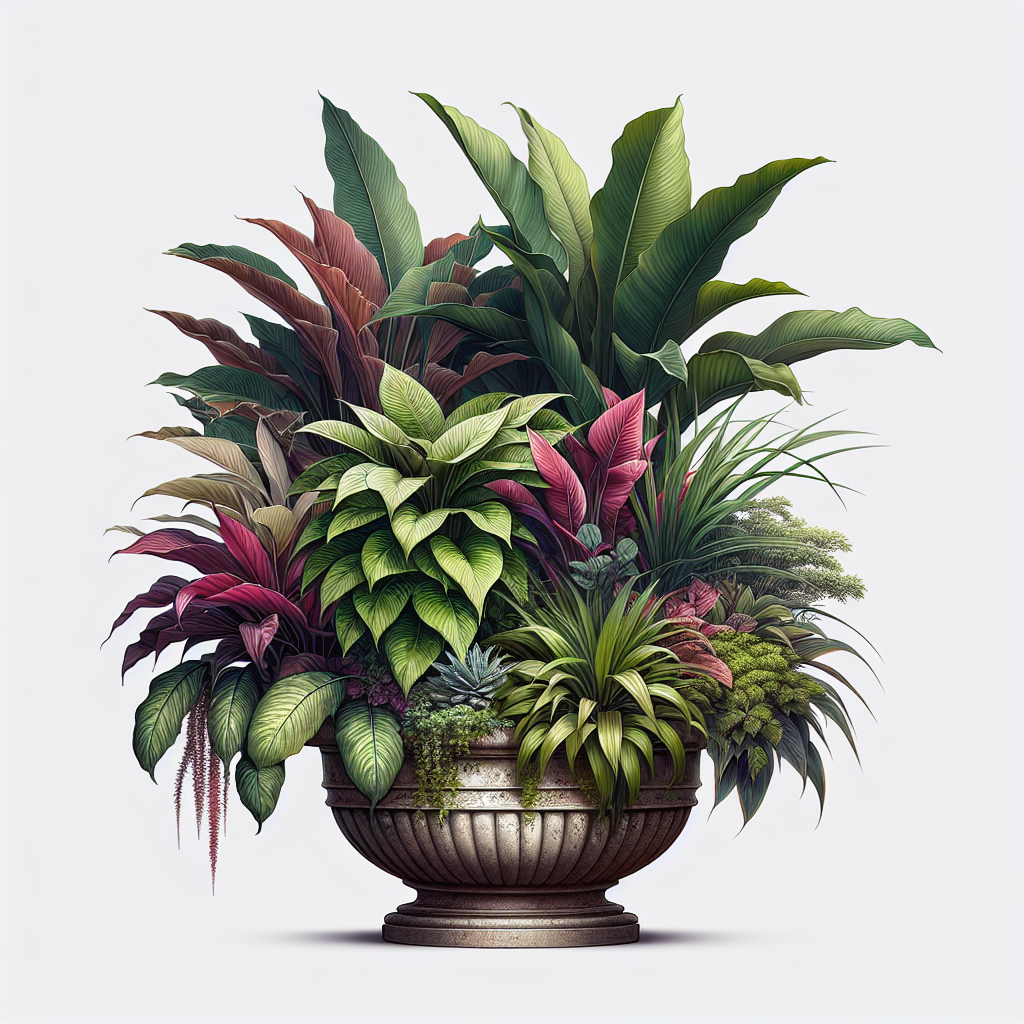Transform Your Patio: Beautiful Herbs for Container Gardening Ideas
November 25, 2024 | by Emma Sage

HERBS FOR CONTAINER GARDENING
3,088 words
Discover the best herbs for container gardening and turn my urban space into a vibrant, green oasis!
Choosing the Right Herbs
When I’m on the hunt for herbs to toss into my containers, I check out how deep their roots wanna go. Not every herb vibes the same in every pot, so it’s kinda like a matchmaking thing—knowing which herbs fit snugly where is your ticket to a thriving little city garden.
Shallow Rooted Herbs for Small Pots
Small pots? No problem! I dig those shallow-rooted champs that don’t need much room. These guys are happy chilling in pots at least six inches deep. Here’s a cheat sheet for the best small-space buddies:
| Herb | Minimum Pot Depth |
|---|---|
| Basil | 6 inches |
| Lavender | 6 inches |
| Lemon Balm | 6 inches |
| Marjoram | 6 inches |
| Oregano | 6 inches |
| Rosemary | 6 inches |
| Sage | 6 inches |
| Thyme | 6 inches |
| Summer Savory | 6 inches |
| Winter Savory | 6 inches |
| Mint | 6 inches |
But, if we’re talkin’ cilantro, cumin, dill, fennel, and parsley, those guys need a foot-deep hangout to really stretch out and live their best life (Gardenary).
Herbs Requiring Deeper Containers
Then, we’ve got the power-players from the Apiaceae crew—these herbs crave a bit more leg room thanks to their big ol’ taproots. If I’m wrangling cilantro, dill, or parsley, it’s foot-deep pots all the way, baby. Here’s the lowdown on what they need:
| Herb | Minimum Pot Depth | Extra Space Suggestion |
|---|---|---|
| Cilantro | 12 inches | 12 inches wide |
| Dill | 12 inches | 12 inches wide |
| Parsley | 12 inches | 12 inches wide |
Make sure those containers are a foot in both depth and width—not only do they give each herb the royal treatment, but they let me party with multiple herbs in one pot. It’s a space-saver’s dream and makes my city garden look oh-so-neat and tidy! (Gardenary)
Picking the right herbs based on their root needs keeps my garden full of happy plants. Wanna dive deeper into the container world? Check out some shade-loving plants or get groovy with drought-tolerant picks. Happy planting, y’all!
Ideal Growing Conditions
Getting my container herb garden to thrive is all about setting up the right scene. A couple of big shots when it comes to getting it right are soil and drainage. Let’s break it down!
Soil Mixture for Container Herbs
When it comes to a solid base for herbs, the soil mix is the secret sauce. I’ve found that a combo of topsoil, compost, sand, and a sprinkle of earthworm castings works wonders. You don’t want it too heavy or too dry, so a nice, loose mix is key (Planet Natural).
Tossing in some organic goodness like garden compost helps keep that precious moisture and perks up the soil’s texture. It’s the perfect setup for herbs that bask in the Mediterranean sun (Jekka’s Blog). Here’s a quick cheat sheet for proportions:
| Ingredient | Recommended Proportion |
|---|---|
| Topsoil | 40% |
| Compost | 40% |
| Sand | 10% |
| Earthworm Castings | 10% |
Importance of Proper Drainage
Making sure my herbs aren’t swimming is equally important. I never forget to pop some holes at the bottom of the containers for drainage. Herbs aren’t fans of soggy roots, and overwatering can really mess things up with root rot (Gardenary).
For those extra worried about drainage, tossing in a layer of tiny rocks or broken bits of pottery can do the trick. It keeps the water moving on and cuts down the chances of waterlogging, keeping my herbs happy and healthy.
By keeping these fundamental aspects in check, I can boast a bustling container herb garden all year round. If you’re curious about more planting ideas, you might want to check out drought-tolerant container plants or veggies that do well in containers.
Planting and Maintenance Tips
On my container gardening adventure, I’ve learned that getting a grip on planting and caring for herbs is a game-changer. Below are some tricks that have turned my herb-growing dreams into reality.
Starting from Seeds vs. Nursery Plants
There’s a certain charm in either kickstarting herbs from seeds or adopting ready-to-go nursery plants. Most herbs fit right at home in a pot and can be seeded yourself or snatched up at garden centers.
| Method | Perks | Bummers |
|---|---|---|
| Starting from Seeds | Cheaper, loads of choices | Takes its sweet time to sprout |
| Nursery Plants | Ready-to-rock, minimal baby-sitting | Can be pricy |
Tender seeds like basil, marjoram, and coriander deserve an indoor start come spring. I like to hang back until that frost threat packs up, then move them outside so they can truly shine.
Watering and Feeding Instructions
Keeping my herbs happy and sprightly is all about the right dose of water and grub. Since pot-bound herbs can’t dig deep for nutrients, they need a high-quality organic fertilizer at planting time. When my herbs throw a sad song or lose color, a liquid fish and kelp boost at half strength works wonders.
| Season | How Often to Water | Fertilizer Plan |
|---|---|---|
| Spring | 2-3 times weekly | Organic boost when planting |
| Summer | 3-4 times weekly | Fish/kelp tonic every month |
| Fall | 1-2 times weekly | Ease up or skip if needed |
| Winter (Indoor) | Once a week | Go easy or skip altogether |
Ensuring my pots get the right amount of water without drowning them is my secret weapon against root rot.

Container Size and Root Health
It’s all about picking the right pot for happy roots. A bigger pot lets roots stretch out, leading to robust, thriving herbs. I aim for pots about 10-12 inches wide, which suits herbs like basil or mint nicely.
| Herb Type | Ideal Pot Size | Special Tips |
|---|---|---|
| Basil | 10-12 inches | Needs constant moisture |
| Mint | 12-16 inches | Tends to wander; bigger pot helps manage |
| French Tarragon | 10-12 inches | Shield from winter chills |
| Coriander | 10 inches | Loves soil that drains well |
For herbs like French tarragon and mint, which might snooze in winter, I slide their pots against a wall or tuck them inside a cold frame. Extra icy days call for bubble wrap or plant fleece as cozy wraps.
Embracing these tips has not only made my container garden bloom but has jazzed up my eco-friendly efforts. For more plant inspirations, check out veggies that vibe with containers and peep some drought-busting container plants for your garden.
Sunlight Needs and Light Sources
Growing herbs in containers is a game of sunshine and shadows. I’ve figured out a few tricks to make sure my little green buddies soak up just the right amount of light and flavor.
Sunlight Requirement for Herbs
Most herbs are sun worshipers, basking in the glow for a solid six hours a day to get those oils bubbling. When I pick spots for my pots, I go straight for where the sun shines. No sun? No fun – the herbs stretch out all skinny and weak like they’re trying to join the circus.
| Herb Type | Sunlight Requirement |
|---|---|
| Basil | Full sun, 6-8 hours |
| Parsley | Partial shade to full sun 4-6 hours |
| Rosemary | Full sun, 6-8 hours |
| Mint | Partial shade to full sun 4-6 hours |
If my herbs start turning into stand-up comedians instead of standing upright, I think about shifting them or getting tricky with some extra lighting.
Supplementing Light Indoors
When winter rolls around or for those sun-challenged spots, I discovered that adding a bit of extra light can turn things around big time. Grow lights or even regular old fluorescent lamps can do the trick. Here’s my scoop on bringing the sunshine indoors for my herb crew:
- Full-Spectrum Grow Lights: They copycat natural sunlight, and that’s just what the doctor ordered for my photosynthesis-loving pals.
- Positioning: I hang out the lights close to the plants—about a half foot to a foot away—to make sure they get their daily dose.
- Duration: Timers are my besties—setting up 12 to 16 hours of light each day keeps things in sync with Mother Nature’s schedule.
This routine helps me keep my herbs lively and kickin’, no matter what Mother Nature’s up to outside. For more plant insights, peep on related reads about shade-loving plants for containers or water-sipping warriors like drought-tolerant container plants.
Keeping my herb gang sun-kissed ensures I’ve got tasty greens to jazz up meals any time of year!
Common Container Herb Issues
Growing herbs in containers feels like tending a little garden world of mine, but let’s face it – there are hiccups along the way. Overwatering, plant potholes, and figuring out the nutrient buffet can really throw a wrench in my green thumb plans.
Overwatering and Root Rot
Watering is the number one rookie mistake I make with my potted herbs. The soil in containers dries out quicker than a cookie left out for Santa, meaning I need to be on my toes with the watering can. I’ve got this routine where I stick my finger into the dirt up to the first knuckle; feels dry? Time to water, but if it’s damp, better hold off. Warm days might get me watering once or twice, just depends.
But if I go overboard, my poor plants might get root rot, making them look like they’re wilting after a breakup – sad leaves, bad news. Using good potting soil or a soil-less mix helps since regular garden soil acts like a sponge that forgot to wring out. Don’t believe me? Planet Natural knows their stuff.
| Symptoms of Overwatering | How to Tell |
|---|---|
| Wilting | Leaves look floppy but soil is soggy |
| Yellow Leaves | Leaves go yellow, then bye-bye |
| Soft, Mushy Roots | Roots are more pudding than plant, all brown and squishy |
Nutrient Deficiencies and Fertilization
Container herbs can be like my picky-eating nephew, requiring just the right nutrients to keep from pouting. Limited space means they need more food than their garden-bed buddies. I throw in some organic fertilizer from the start, and if they start losing their groove, I whip up some half-strength liquid fish and kelp fertilizer. Bonus points if I don’t spill it everywhere (Planet Natural would back me up here too).
Different nutrients give my plants different headaches. Yellowy leaves might mean they’re low on nitrogen, whereas slowpoke growth suggests missing minerals. Here’s my cheat sheet for herb trouble:
| Nutrient Deficiency | What’s Going On |
|---|---|
| Nitrogen | Leaves going yellow, growth takes a nap |
| Phosphorus | Dark leaves turn purple, short and stubby vibes |
| Potassium | Edges of leaves look like they’ve been toasted, wobbly stems |
Keeping tabs on my plants’ needs helps me avoid garden drama. They pay me back with fresh scents and flavors – totally worth the effort. For more green-thumb goodness, check out our insights on vegetables that are container-friendly and plants that don’t mind droughts in containers.
Container Herb Cultivation Benefits
Growing herbs in containers brings a bunch of benefits that spice up both my cooking and gardening efforts. Let’s dig into some of the perks of having herbs in pots.
Saving Money and Upping Flavor
One big win for growing my own herbs is saving some cash. Buying fresh herbs at the store can make your wallet feel lighter pretty quick, especially if you’re a frequent user like me. When I grow my own, I’m cashing in on savings and, let’s be honest, the taste is just on another level. None of that limp, dull stuff you sometimes drag home from the store. Homegrown herbs? They taste awesome, stick around longer, and really add something special to my dishes. It’s a win-win that you find yourself savoring. Jekka’s Herb Farm backs me up, saying growing your own means saving bucks and getting unbeatable flavor, too.
| Benefit | Details |
|---|---|
| Cash Savings | A lot cheaper than buying pre-packaged herbs |
| Flavor Excellence | Beats what you get at the store any day |
| Lasting Freshness | Stays fresh longer, no need for preservatives |
Welcoming Wildlife and Bee Party
There’s something sweet about seeing bees and butterflies buzz around my container herbs. Not only do they jazz up my garden, but they help with pollination which is sort of like throwing a shindig for the ecosystem. Watching these vibrant guests flutter about and play host is really rewarding.
When I plant herbs that wildlife love, it’s like creating a tiny paradise that helps out my meal prep and gives a little back to nature. Some herbs are magnets for pollinators, making them a charming addition to any garden scene. If space is tight outside, container herbs are a fabulous way to attract these pals while still getting your garden groove on.
| Wildlife Magnet | Herb Examples |
|---|---|
| Bee Favorite | Lavender, Oregano, Basil |
| Butterfly Attraction | Thyme, Chives, Mint |
| Boosts Biodiversity | Parsley, Dill, Fennel |
Growing herbs in containers turns my spot into a green haven, putting extra zing in my cooking and cheering on the environment. It’s a mix of sustainability and doing things the organic way, which jives with what I care about. If you’re curious about what else you can stick in your pots, dive into veggies that love containers or plants that laugh at drought.
Happy Gardening,
Emma Sage
RELATED POSTS
View all



